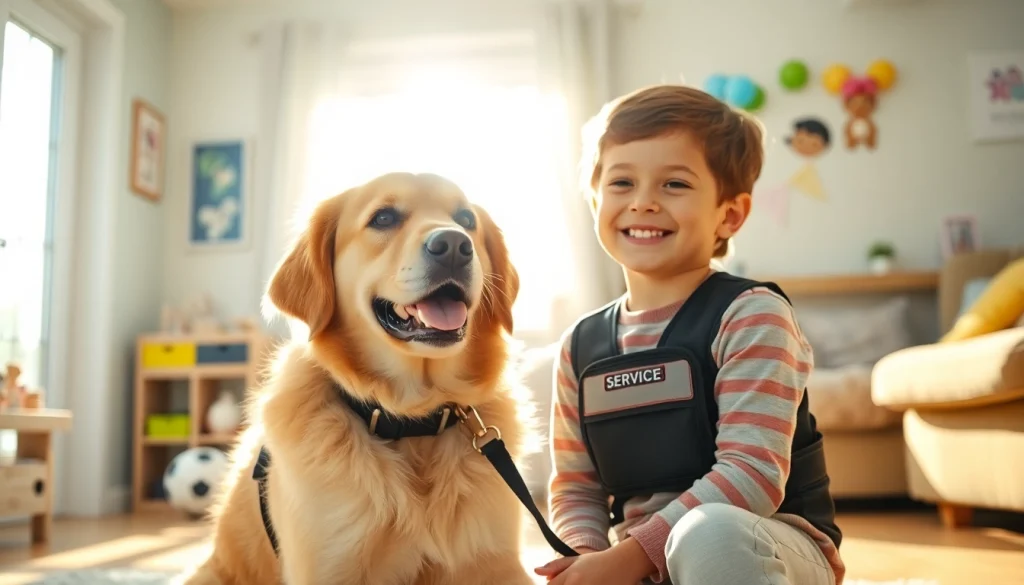Understanding Service Dogs
What is a Service Dog?
A service dog is a specially trained dog that assists individuals with disabilities, enabling them to lead more independent lives. These dogs perform a variety of tasks ranging from mobility assistance to providing emotional support. Unlike emotional support animals or therapy dogs, service dogs are trained to perform specific tasks directly related to their handler’s disability. Under the Americans with Disabilities Act (ADA), service dogs are recognized and afforded special access rights in public accommodations.
Types of Service Dogs
Service dogs can be categorized based on the types of disabilities they address. Here are some common types:
- Mobility Assistance Dogs: These dogs help individuals with mobility challenges perform daily tasks such as retrieving items or opening doors.
- Medical Alert Dogs: Trained to alert individuals to medical emergencies, such as an impending seizure or insulin drop.
- Psychiatric Service Dogs: These dogs assist individuals with psychological disorders by performing tasks that mitigate symptoms, such as providing grounding during anxiety attacks.
- Autism Service Dogs: Specifically trained to help manage social interactions and provide a source of comfort to individuals with autism spectrum disorders.
Legal Rights Regarding Service Dogs
Under the ADA, individuals accompanied by service dogs have the right to access public places, including restaurants, stores, and transportation. It is important to note that businesses are not allowed to require proof of certification or registration, nor can they deny access based solely on breed or size.
Eligibility Criteria to Get a Service Dog
Disabilities That Qualify
Service dogs are typically designated for individuals with physical, psychological, or emotional disabilities. Qualifying disabilities may include, but are not limited to:
- Mobility impairments
- Visual or hearing impairments
- Post-Traumatic Stress Disorder (PTSD)
- Anxiety and panic disorders
- Autism Spectrum Disorder (ASD)
- Severe depression
Assessment Processes
To determine eligibility for a service dog, individuals are often required to undergo evaluations conducted by healthcare professionals. These assessments help verify whether a disability substantially limits major life activities, warranting the need for a service dog.
Documentation Requirements
Documentation is essential when seeking to get a service dog. This may include medical records, a letter from a licensed mental health professional, or other pertinent health documentation that outlines the need for a service dog as well as the specific tasks the dog will assist with.
How to Get a Service Dog
Finding a Reputable Organization
Finding the right organization is crucial for securing a suitable service dog. Prioritize organizations that are accredited by professional associations and have a proven track record of training and placing service dogs. Look for reviews and testimonials from previous clients.
Application Process Breakdown
The application process for acquiring a service dog often involves several steps:
- Initial Inquiry: Fill out an application form that typically includes personal details and information about your disability.
- Interview: Partake in an interview process to assess compatibility and specific needs.
- Training Assessment: Determine what type of training the service dog will require based on your disability.
- Placement Process: Once matched, the organization will facilitate the introduction and basic training to ensure compatibility.
Costs and Funding Options
The cost associated with acquiring a service dog can vary significantly based on the training and organization. Some trained service dogs can cost upwards of $20,000. However, various funding options are available, including:
- Grants from non-profit organizations
- Fundraising campaigns
- Crowdfunding platforms
- Support from community programs
Training Your Service Dog
Training Programs Overview
Service dog training encompasses a wide array of tasks specific to the handler’s needs. This may include basic obedience, task-specific training, and socialization. Training programs often range from several months to over a year, depending on the complexity of tasks required.
Owner Training vs. Professional Training
While some owners may choose to train their own service dogs, professional training is often recommended. Professional trainers have the expertise to ensure that the service dog meets legal standards and performs necessary tasks reliably. Owner training can complement professional training by fostering the bond between the human and dog. It also helps the owner learn specific commands and routines tailored to their lifestyle.
Ongoing Training and Support
After completing initial training, service dogs require ongoing training and socialization to maintain their skills. Regular practice helps reinforce learned behaviors, and continued support can involve attending workshops or refresher courses offered by service dog organizations.
Lived Experiences with Service Dogs
Personal Stories of Independence
Numerous individuals have shared transformative stories about how service dogs have improved their quality of life. Service dogs often empower their handlers to regain independence, reducing reliance on others and enhancing self-esteem.
How Service Dogs Improve Quality of Life
Service dogs benefit their handlers in numerous ways beyond physical assistance. Emotional support provided by service dogs significantly alleviates feelings of anxiety, loneliness, and depression. The presence of a service dog has been found to foster social engagement and improve overall emotional well-being.
Community Support and Resources
Integration into the community is vital for service dog handlers. Support groups can provide a forum to share experiences, challenges, and successes, ultimately enriching the lives of individuals with service dogs. Community resources, such as local organizations and online forums, offer invaluable information, support, and companionship for individuals navigating life with a service dog.
